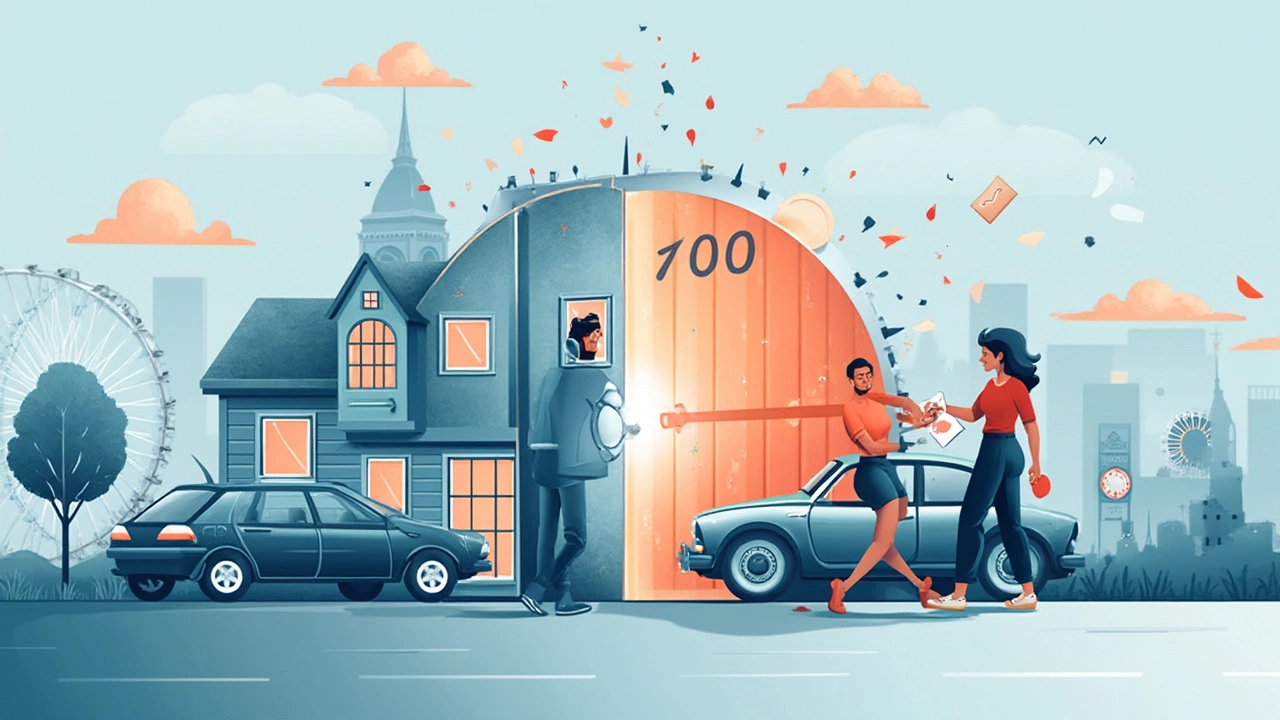A 700 credit score feels like a magic number if you’ve ever stressed about borrowing money or getting a new credit card. The truth is, this score opens doors that a 600-something just can't. You might be thinking, is it rare or is everyone getting there? Actually, about 1 in 5 Americans have a score somewhere between 700 and 749. It’s not as elite as you might think, but hitting this line puts you ahead of the curve.
A score of 700 pushes you straight into ‘good credit’ territory. Lenders, banks, and credit card companies usually see you as a stable bet. This can mean better interest rates, higher credit limits, and easier approval for cards with real rewards, not just basic perks. So even if you’re staring at your latest credit report feeling stuck at 690, you’re closer than you realize—and the payoff is worth it.
- What Does a 700 Credit Score Mean?
- How Many People Have a 700 Credit Score?
- Why Lenders Care About the 700 Mark
- Common Ways to Reach or Maintain 700
- Credit Card Benefits and Next Steps
What Does a 700 Credit Score Mean?
Seeing a 700 credit score on your report is a real milestone. On the FICO scale, which ranges from 300 to 850, a 700 falls solidly in the “good” range. Most lenders and credit card companies spot that number and instantly know you manage your money pretty well. This isn’t just about paying bills on time either. It means you keep your balances in check, don’t run up a bunch of debt, and avoid any major slip-ups like late payments or collections.
Here’s what makes a 700 stand out:
- It’s higher than the national average, which hovers around 715 as of early 2025, but way better than most younger adults or new credit users get.
- Credit bureaus like Experian and Equifax count a 700 as “good,” putting you a step below “very good” (740 or higher) and far above “fair” (580-669).
- With a 700, you’re a lot less likely to get rejected for regular credit cards, auto loans, or home mortgages—assuming your income adds up.
Check out this quick breakdown for how a 700 stacks up on the FICO chart:
| Credit Score Range | Category |
|---|---|
| 800-850 | Exceptional |
| 740-799 | Very Good |
| 670-739 | Good |
| 580-669 | Fair |
| 300-579 | Poor |
So, a 700 credit score doesn’t mean you’ve totally maxed out your options, but it’s enough to give you real leverage. You’ll usually see lower interest rates on big loans, and you can finally apply for credit cards that come with sweet perks—like miles, cashback, or welcome bonuses—without worrying so much about getting denied.
Basically, a 700 isn’t perfection, but it means you’re doing a lot right, and you’re set up to make the most out of your borrowing power.
How Many People Have a 700 Credit Score?
So, how hard is it to join the 700 credit score club? Turns out, it’s actually more common than you might think. According to Experian’s Consumer Credit Review, about 21% of Americans have a credit score between 700 and 749. If you look at the bigger picture, nearly 69% of people in the U.S. have a score of 670 or higher. That means almost 2 out of 3 adults are walking around with good credit or better.
Here’s a quick breakdown to put things in perspective:
| Credit Score Range | Percent of Population |
|---|---|
| 800-850 | 23% |
| 750-799 | 27% |
| 700-749 | 21% |
| 650-699 | 13% |
| 600-649 | 10% |
| Below 600 | 6% |
If you’re in that 700-749 group, you’re already ahead of almost half the country. Not bad, right?
Check out this quote from Rod Griffin, senior director of public education at Experian:
“Reaching a 700 credit score is a milestone for many, and it means you’re likely to get better loan terms and a smoother borrowing process.”
So, when you’re comparing credit cards and thinking about your next financial move, knowing that you’ve hit 700 puts you on solid ground. It means you’ve managed your credit history better than most. And if you’re not there yet, these numbers show it’s totally doable—and worth the effort to get there.

Why Lenders Care About the 700 Mark
If you’ve ever wondered why banks and credit card companies perk up at a 700 credit score, it’s actually pretty simple. Lenders see a 700 as proof that you know how to handle credit and pay your bills on time. This number isn’t magic—it’s just the point where people show they’re less risky to lend to. The whole system is about trust. Lenders want to know you’ll pay them back, and a 700 score tells them you’ve done it well so far.
Let’s look at it through the numbers. According to Experian’s 2024 data, borrowers with a score of 700 or above have much lower default rates. The average credit card APR (interest rate) for people in the high 600s is around 27%, but if you hit 700, that drops closer to 21%. Lenders save money on risky customers, and you save money when you prove you’re not one.
| Credit Score Range | Average APR | Loan Approval Rate |
|---|---|---|
| Below 700 | 27% | ~45% |
| 700+ | 21% | ~70% |
That’s a serious difference. A 700 credit score often means:
- Lower interest rates on credit cards and loans
- Bigger credit limits (more spending power)
- Higher chances of approval for premium cards and mortgages
- Less hassle—fewer hoops to jump through during the application
Lenders get picky because it’s their money on the line. The 700 mark draws a clear line: people above it are less likely to miss a payment, so lenders want their business. It’s not about being perfect. It’s about being reliable and steady over time.
Common Ways to Reach or Maintain 700
If you're eyeing that 700 credit score, there’s a repeatable formula. Hitting and hanging onto 700 takes more consistency than magic. After all, credit rules don’t really change, but the best habits aren’t always obvious at first glance.
One big thing—always pay your bills on time. Payment history is the heavyweight here: it makes up about 35% of your overall score. So even one missed payment can drag your score down for months. If you’re forgetful, setting up automatic payments is your friend.
Another tip: keep your credit card balances low. Experts usually say to keep your credit utilization below 30%, but shooting for 10% or less is even better. You don’t need to carry a balance to look good. In fact, zero credit card debt is the dream for most folks trying to climb the ranks.
“A good credit score starts with good habits—on-time payments, responsible use, and occasional checks for accuracy,” says Ted Rossman, senior industry analyst at Bankrate.
Also, don’t close your old cards unless you really have to. The age of your accounts matters. Lenders like seeing a long, steady history. Even if you don’t use a card often, keeping it open (with a zero balance) is usually smart for maintaining a healthy score.
Checking your credit report for errors matters more than people expect. According to the Consumer Financial Protection Bureau, about 1 in 5 Americans found an error on their credit reports that could affect their scores. If you spot a mistake, dispute it quickly—fixes can bump your score overnight.
| Factor | Weight in Score | Quick Tip |
|---|---|---|
| Payment History | 35% | Never miss a due date |
| Credit Utilization | 30% | Try to stay under 10% |
| Credit Age | 15% | Don’t close old cards |
| New Credit | 10% | Limit new applications |
| Credit Mix | 10% | Mix of cards and loans helps |
If you’re rebuilding after a setback, consider a secured card to get back on your feet. Or, ask to be added as an authorized user on someone else’s well-handled account. These moves can add positive history in a short time. Consistency is the key, and once you’re at 700, keeping up these habits is way easier than recovering from a late payment or suddenly maxed-out card.

Credit Card Benefits and Next Steps
Once you reach a 700 credit score, you gain access to a much wider range of credit cards. Lenders see you as reliable, so they’re more eager to offer perks that aren’t on the table for those with lower scores. Forget starter cards with sky-high fees—now you can qualify for rewards cards, travel perks, and cash back offers that actually mean something.
If you’re wondering what changes at this score, check out how average advertised credit card rates and offers compare when your score hits 700:
| Credit Score Range | Typical APR (%) | Rewards Cards Available | Average Credit Limit |
|---|---|---|---|
| Below 670 | 23.5 | Few | $1,500 |
| 700–749 | 19.2 | Most | $4,500 |
| 750+ | 16.7 | Nearly All | $9,000 |
Now you’re in the sweet spot for cards with sign-up bonuses, 2% cash back, and travel insurance. Big issuers—think Chase Sapphire Preferred or Capital One Venture—look for applicants right in the 700+ range. This means your odds of getting approved are much higher and you might start seeing pre-approval offers in your mailbox or email.
Here’s what to do next if you’re at—or near—the 700 credit score range:
- Shop around. Use a credit card comparison tool to see which perks really matter to you—like extra points on groceries or no annual fee.
- Don’t apply for too many cards at once. Each application dings your score a bit. Focus on 1–2 cards with the rewards and rates that fit your lifestyle.
- Read the fine print. Awesome travel points don’t help if you hate flying. Look for things you’ll actually use.
- Watch your credit limit. When your credit card limit jumps, don’t go wild—keep your debt-to-limit ratio under 30% to help maintain that good score.
- Pay on time, always. It’s the quickest way to keep building from here or protect what you’ve earned.
If you want to stretch your score even higher, set up reminders for payments and consider asking for a credit limit increase every year. Some folks get a boost just by fixing errors on their credit report. The leap from 700 to 750 isn’t out of reach—and the perks get even bigger up there.

